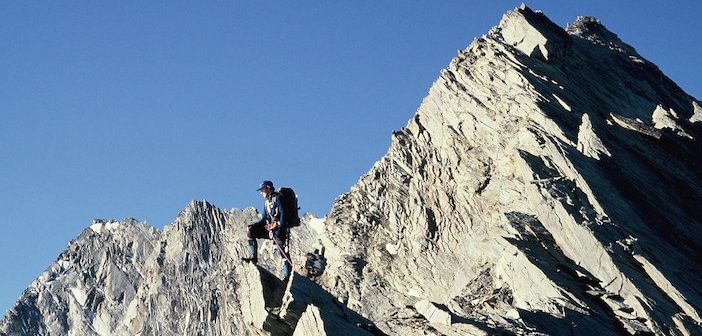Since the publication of his first book Mountains of the Mind in 2003, Robert Macfarlane has gone on to establish himself as a leading writer on the culture and language of the natural world.Mountains of the Mind was a well-deserved success when it was first published and resulted in its author receiving the Guardian First Book Award, the Somerset Maugham Award, and the Sunday Times Young Writer of the Year Award. I am glad to report that Granta has re-published the book in a 20th anniversary edition not least because my original copy eventually fell apart in some mountain hut after too long spent getting battered in a pocket of my rucksack. Re-reading the book has amply renewed the pleasures it provided first time around.
 Mountains of the Mind is not just a book for mountaineers. It is for anyone who has an interest in mountains, even if just from the viewpoint of an armchair or a roadside halt. It is above all a history of European humankind’s changing relationship with mountains both at home and abroad. Eurocentric it inevitably is as it was in Europe mountains first became both a laboratory and a playground. In tracing this relationship Macfarlane has produced an elegant and erudite literary and cultural history interwoven with elements of his own experiences of the beauty of mountain landscapes and of the physical risks and demands that accompany adventuring amongst them.
Mountains of the Mind is not just a book for mountaineers. It is for anyone who has an interest in mountains, even if just from the viewpoint of an armchair or a roadside halt. It is above all a history of European humankind’s changing relationship with mountains both at home and abroad. Eurocentric it inevitably is as it was in Europe mountains first became both a laboratory and a playground. In tracing this relationship Macfarlane has produced an elegant and erudite literary and cultural history interwoven with elements of his own experiences of the beauty of mountain landscapes and of the physical risks and demands that accompany adventuring amongst them.
What emerges from the story Macfarlane tells is the increasingly romantic attitude towards mountains that has come to dictate so much of the response of those who venture amongst the high places of the planet. This is especially evident both in the story of George Mallory and his obsession with climbing Everest with which Macfarlane brings his book towards a close and in the way that he writes about his own mountain experiences. Indeed, as he describes it himself, his book is not so much a history of mountaineering as a history of the imagination. This is not least because the mountains that people ‘gaze at, read about, dream of and desire ‘ to quote Macfarlane, are not the same as the harsh reality they confront in the mountains they end up trying to climb.
Macfarlane’s journey starts with mountains as places to be feared, places not just of physical danger, of wild storms and avalanches, but also where violent and savage people were to be found including those suspected of supernatural powers such as witches. A gradual change takes place as early geologists and fossil hunters came to see them as laboratories where they could explore and explain the world in which they lived without relying on myth and magic.
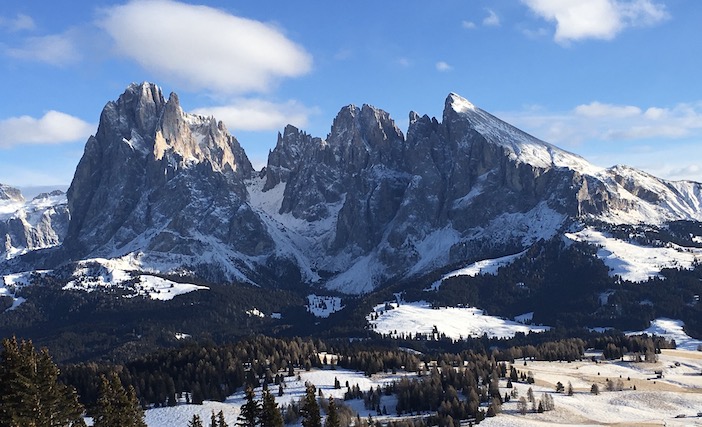
Langkofel and Plattkofe in the Dolomites
Macfarlane’s chapter The Great Stone Book is one of the most illuminating as he moves from the theories of Thomas Burnet on the origins of mountains in The Sacred Theory of the Earth published in 1682 to the 1960s and the new theory of tectonic plates. What the geologists and the fossil hunters brought with their explorations was a completely different sense of time. In 1650 Archbishop Ussher of Armagh calculated the birth of the earth back to 4004 BC, a modest 5654 years. By the 1870s the timeline had become hundreds of millions of years.
Following in the footsteps of the scientists came the artists and writers such as Coleridge, Wordsworth, Shelley, Byron and Ruskin and it was they who started to create the romantic image of mountains that has remained attached to them ever since. For some it became a search for the sublime, for the elevated experiences that wild landscapes stimulated and could, as Shelley wrote ‘stir violent emotions’. As cities grew apace, driven by the Industrial Revolution and the population growth that accompanied it, so mountains provided an escape from the noise, smell, polluted air, and dull routines of this new urban world. It did not take long for mountains to become a playground for the adventurous and the eccentric as climbing to the summits became a badge of manhood and courage as well as providing stories that the entrepreneurial could sell. As the Alps became crowded so the most adventurous set out to travel further afield to where the map was still empty and the mountains unnamed – at least by their European explorers.
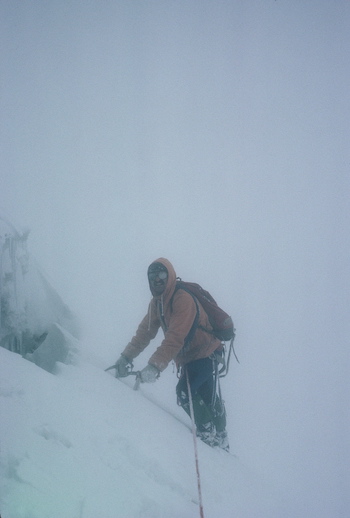
On the Brenva face of Mont Blanc
Macfarlane explains with a delicate touch this attachment to wild, empty, and savage places, not always high ones, that captured the hearts and minds of so many Britons. He also includes a wonderful example of the entrepreneurial spirit at its most flamboyant and absurd. Albert Smith climbed Mont Blanc in 1851 and then from 1853 ran a sell-out show for six years in a hall in Piccadilly. However dramatically Smith, a sedentary man at heart, may have presented the story of his ascent in Piccadilly, it was not a triumph of athleticism and individual effort. In practice it was, if anything, a triumph over alcohol poisoning as he was assisted in his ascent not only by a cavalcade of guides but also by 96 bottles of assorted wines and spirits.
For all the romanticism and literary brio that permeates his book Macfarlane has no illusions about the brutal reality that permeates mountaineering whatever the level of difficulty. He follows the entertaining story of Albert Smith with that of a tragic disaster in 1870 when a party of eleven were trapped in a storm high on the Mont Blanc after a successful ascent and froze to death. Two of his most memorable personal vignettes also expose the risks that can appear almost from nowhere, however careful the mountaineer – rockfall and weather. In one vignette it is only the arbitrary trajectory of the falling rocks that enable his survival when climbing in the Alps. In the other, it is his good fortune in finding snow deep enough to dig a shelter when unexpectedly hit by an arctic storm in the Cairngorms.
It is not for nothing that Macfarlane draws attention to both the sage words of Edward Whymper, who first climbed the Matterhorn and survived the accident that killed four of his party on the descent or to some of the books of Joe Simpson. Some six years after the triumph and disaster on the Matterhorn Whymper wrote: ‘climb if you will, but remember that courage and strength are nought without prudence, and that a momentary negligence may destroy the happiness of a lifetime. Do nothing in haste; look well to each step, and from the beginning think what may be the end.
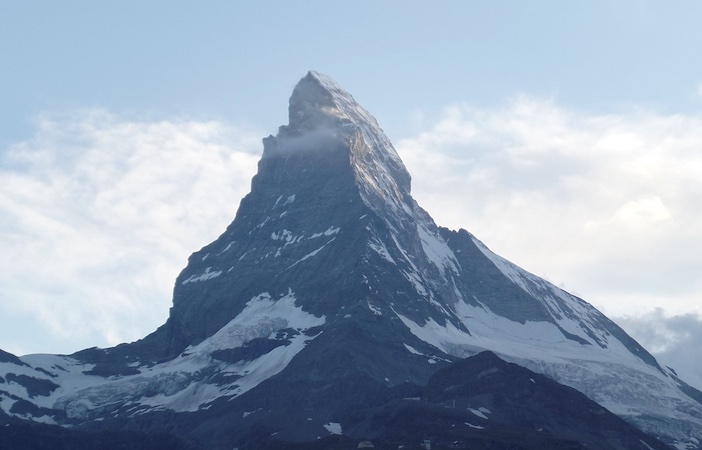
The Matterhorn
To underline the dangers of mountaineering and the gap between romance and reality Macfarlane mentions the title of Joe Simpson’s book The Beckoning Silence. An equally apposite title is that of Simpson’s earlier book This Game of Ghosts, especially given the relentless death toll it contains. The current mountain death toll in the Mont Blanc massif is around one hundred every year. The death count began not long after the first ascent of Mont Blanc as people started to venture above the snow line in greater numbers as well as onto the rocky ridges that provided the obvious routes to so many inspiring summits. For all the beauty and excitement they provide mountains can exact a heavy price.
Macfarlane has written a Preface for this anniversary addition in which he suggests that the romanticism that has played such an important role in the relationship between man and mountain, one-sided though it may be, has been replaced in some part by the tick-box commercial culture of the selfie and the TikTok influencer; a change best summed up by the 2019 photo of the traffic jam of 200 people on the summit ridge of Everest; most of whom were only able to be there because they had paid huge sums of money to have others prepare the way and then drag them up fixed ropes to the summit.
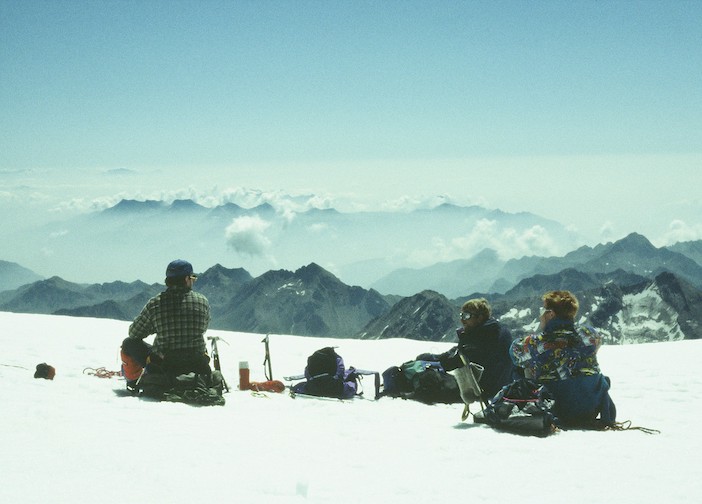
That said, I believe, as I think Macfarlane does, that most people who venture into the mountains are still driven, to a greater or lesser extent, by the romantic attachment that Macfarlane describes so eloquently. For some it may be the physical challenges and sense of adventure that mountains provide; for others the beauty of mountain landscapes whether the rock architecture, the snow-capped peaks, glaciers gleaming in the sunlight, the endless changing light, or the silence except for sound of the wind; for some the enjoyment of a shared experience and for others an escape from the noise of modern city life.
I suspect that for most it is some combination of all. Mountains of the Mind may be twenty years old, but it has aged well and remains as elegantly written, stimulating, and thought provoking as it was when it was first published. Berg heil!
Winner of the Guardian First Book award, Mountains of the Mind 20th Anniversary edition by Robert Macfarlane is out now in paperback and ebook, published by Granta. For more information, please visit www.granta.com.
Photos courtesy of Philip Cottam

